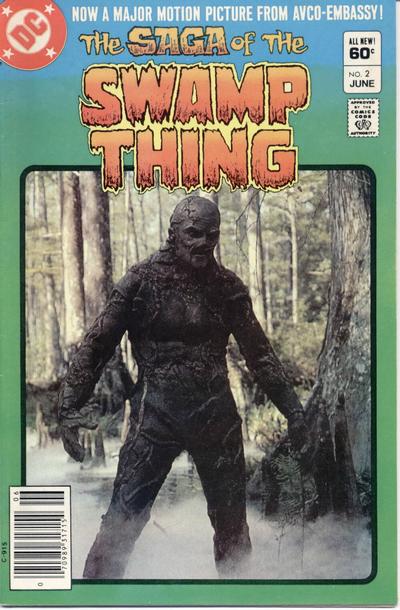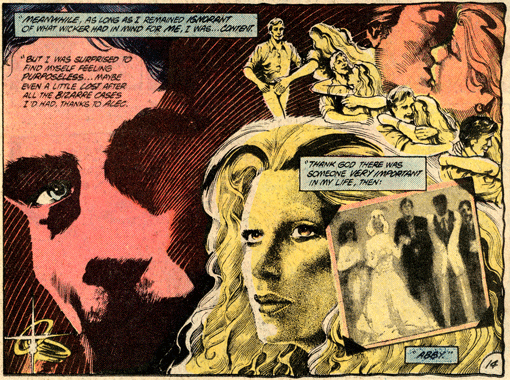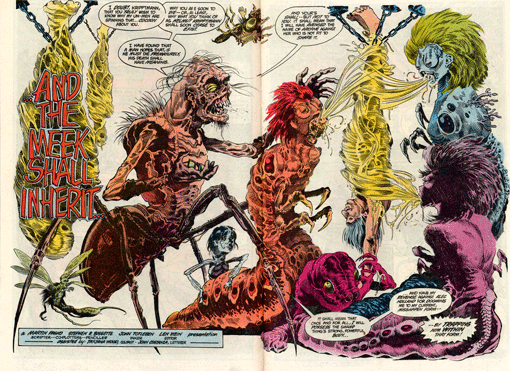First, when the movie version of Watchmen comes out next year, I hope the filmmakers have the wit to invite Wes Craven to the premiere. Without Craven, their film probably would not exist because the Swamp Thing run by Alan Moore would not exist. The version of the book on which Moore cut his teeth at DC was originally launched to tie in to Craven's Swamp Thing movie. The second issue of this run even had letters of encouragement from Craven himself and actor Dick Durock, who played the character on screen. It used a still from the movie on the cover:

Second, I think two periods of the book's first and second runs have been unfairly overshadowed by the bookends of the Len Wein/Berni Wrightson era and the Alan Moore/Stephen Bissette/John Totleben era. There isn't anything wrong with Nestor Redondo's art on the post-Wrightson issues, except, of course, that he's not Wrightson. And the Marty Pasko issues that precede Alan Moore's run on the book are pretty good. What isn't discussed much about the Alan Moore run is that great whacks of it are built upon and reference Pasko's stories, from the corporate bad guys who have it in for the Swamp Thing to a couple of the stand-alone adventures. Moore's interpretation of the supporting cast of the original series--Matt Cable and Abigail Arcane--derives directly from their depiction by Pasko rather than the one found in the series original run. There's at least one of Marty Pasko's issues, the Twilight Zone-y 16th issue, that's easily as good as any of the Alan Moore issues. Hell, it's better than some of them.
Third, I think Alan Moore lucked into an astonishingly good situation with the art team he inherited. I had been buying the book from the outset, though by the time the book was in the mid-teens, I was wavering. I skipped an issue or two of the later Tom Yeats issues (I filled them in after the fact), but when Bissette and Totleben came on the book, I was hooked. I had been a huge fan of the work they had done in Marvel's black and white magazines, particularly "The Blood Bequest," a waaaaay over the top Dracula story, and "A Frog is a Frog," which is one of my favorite horror stories in any medium from the 1980s. Bissette had been contributing layouts for Swamp Thing during Tom Yeats's run on the book, and invariably, they were Yeats's best pages. When he and Totleben took over the book full-time, there was a noticeable jump in quality .
I should note, in passing, that I liked Tom Yeats's art. It was dark and moody and classical, in the tradition of Berni Wrightson. But it wasn't batshit insane, which Bissette and Totlebens' art categorically was.
In any event, I have some serious doubts about whether or not Moore's initial success would have been as large as it was without the contributions of his artists. Tonally, his first couple of stories are very similar to Pasko's, though they are very different in terms of narrative technique. The work that Bissette and Totleben were already doing was amazing. Take for instance this panel from issue #17:

This is much more tonally dense than Yeats's work, not just in terms of image, but also in terms of technique. There are several separate and distinct methods of drawings working in this panel, and they throw in a photographic element as well.
I'm also fond of this scene, a couple of pages later:

For the most part, I think Pasko as a writer gave the artists their heads. I don't know if Pasko wrote using the Marvel method (in which he provided a plot for his artists and filled in the dialogue after the fact), or if he wrote full scripts. Based on the results, I rather suspect the former, because every so often, they would cut loose with something like this, from issue #19:
(click the image for a larger version)
Moore's sensibility seems to have been more closely in tune with the artists, though, because when they were clicking, they were unbeatable. This is my favorite page from the Moore run, the splash page of issue #42. It's positively droll:

Enjoy.
